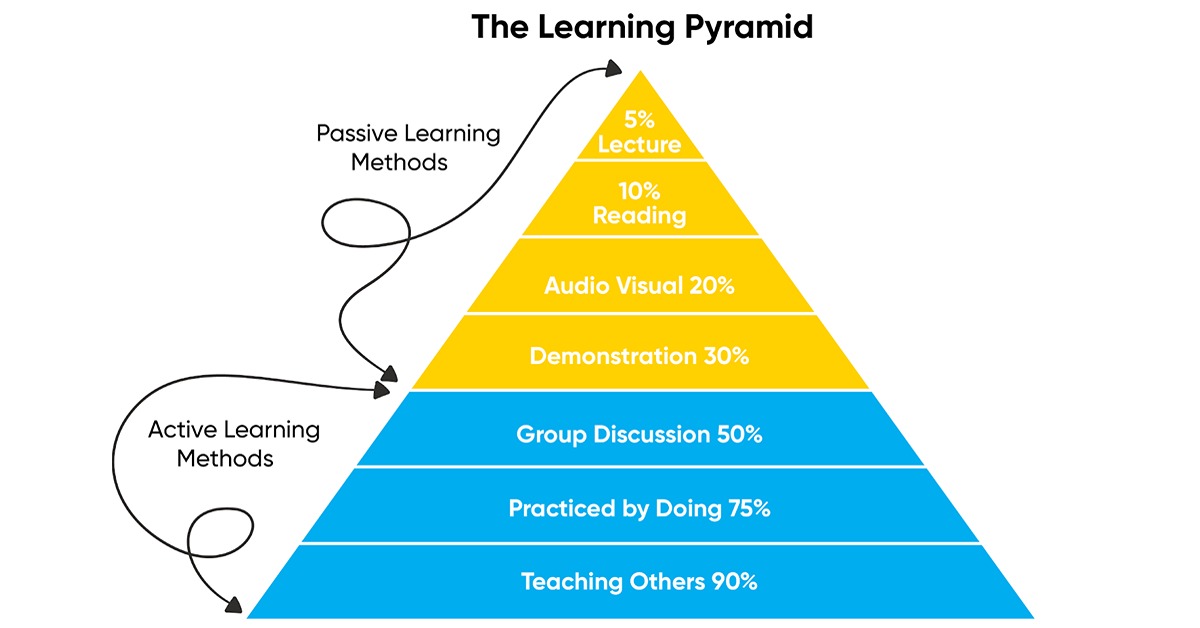
Levels of Learning pyramid
The Learning Pyramid is a visual model that illustrates the relative effectiveness of different learning methods. By understanding the principles behind this pyramid, we can optimize our learning strategies and maximize our retention of information. Let’s delve into the different levels of the Learning Pyramid and explore how they can be applied to enhance our learning experiences.

What is Learning Pyramid?
The Learning Pyramid, also known as the Cone of Learning, is a model that illustrates the effectiveness of different learning methods. It suggests that the more actively involved learners are in the learning process, the more they retain information.
Here’s a breakdown of the Learning Pyramid:
- 5% Lecture: Passive listening, with minimal engagement.
- 10% Reading: Reading information, with limited interaction.
- 20% Audio-Visual: Watching videos or presentations, which can be engaging but still passive.
- 30% Demonstration: Observing a demonstration, which can be helpful for understanding a process or skill.
- 50% Discussion Group: Engaging in discussions with others can deepen understanding and critical thinking.
- 70% Practice: Actively practicing a skill or concept through exercises and problem-solving.
- 90% Teach Others: The most effective method, as teaching forces learners to consolidate their knowledge and explain it to others.
The key takeaway from the Learning Pyramid is that active learning strategies, such as practice, discussion, and teaching others, are significantly more effective than passive methods like listening to lectures or reading. By incorporating a variety of active learning techniques into your studies or training, you can improve your retention and comprehension.
Why is Learning Pyramid important?

The Learning Pyramid is a valuable tool for understanding how different learning methods impact information retention. By delving deeper into its principles, we can optimize our learning strategies and achieve better results.
Here’s why understanding the Learning Pyramid is crucial:
1. Identifying Effective Learning Strategies:
- Prioritizing Active Learning: The pyramid emphasizes the importance of active learning techniques, such as practice, discussion, and teaching others. By focusing on these methods, learners can significantly improve their retention and comprehension.
- Minimizing Passive Learning: While passive learning methods like lectures and reading can be helpful, they are less effective for long-term retention. By incorporating more active learning strategies, learners can maximize their learning potential.
2. Tailoring Learning Experiences:
- Personalized Learning: By understanding the pyramid, learners can tailor their study habits to their individual learning styles. Some may prefer visual learning, while others may benefit from hands-on activities.
- Effective Teaching Methods: Educators can use the pyramid to design more engaging and effective lessons by incorporating a variety of active learning strategies.
3. Enhancing Learning Outcomes:
- Improved Retention: By employing active learning techniques, learners can retain information for longer periods.
- Deeper Understanding: Active engagement with the material fosters a deeper understanding of concepts.
- Enhanced Problem-Solving Skills: Applying knowledge through practice and discussion improves problem-solving abilities.
4. Promoting Lifelong Learning:
- Self-Directed Learning: The pyramid encourages self-directed learning, empowering learners to take control of their own education.
- Continuous Improvement: By understanding the effectiveness of different learning methods, learners can continuously improve their learning strategies.
By understanding the Learning Pyramid and applying its principles, individuals can become more effective learners and achieve their full potential.
Applying the Learning Pyramid in Learning and Teaching

The Learning Pyramid offers valuable insights into effective learning strategies. Here’s how you can apply its principles in both learning and teaching:
For Learners:
- Active Learning:
- Practice: Regularly practice what you’ve learned through exercises, quizzes, and real-world applications.
- Teach Others: Explain concepts to friends, family, or study groups. This solidifies your understanding and helps identify knowledge gaps.
- Discussion Groups: Participate in discussions and debates to gain different perspectives and deepen your understanding.
- Visual Learning:
- Create Visual Aids: Use mind maps, diagrams, and flashcards to visualize information.
- Watch Videos: Educational videos can enhance understanding and make learning more engaging.
For Teachers:
- Diverse Learning Activities:
- Hands-on Activities: Incorporate activities like experiments, simulations, and role-playing.
- Group Work: Encourage students to collaborate and learn from each other.
- Real-world Applications: Connect the material to real-world situations to make it more relevant.
- Effective Assessment:
- Formative Assessment: Use quizzes, tests, and projects to assess student understanding and provide feedback.
- Summative Assessment: Evaluate student learning at the end of a unit or course.
- Create a Positive Learning Environment:
- Encourage Questions: Foster a classroom culture where students feel comfortable asking questions.
- Provide Support: Offer support and guidance to students as needed.
- Celebrate Success: Recognize and reward student achievements.
By understanding and applying the principles of the Learning Pyramid, both learners and teachers can enhance the learning experience and achieve better outcomes.
See also:
Feelings Worksheet: A Social-Emotional Learning Approach
Part-time ESL Teacher in Long Bien
Real-World Examples of the Learning Pyramid in Action
1. Education:
- Traditional Lecture: A teacher lectures on a specific topic. While this method can be effective for introducing new information, it relies heavily on passive learning.
- Interactive Lecture: A teacher incorporates questions, discussions, and group activities into the lecture, making it more engaging and interactive.
- Hands-on Activities: Students participate in experiments, simulations, or projects, applying their knowledge in a practical way.
- Peer Teaching: Students teach each other, reinforcing their understanding and developing their communication skills.
2. Workplace Training:
- On-the-Job Training: Employees learn by doing, gaining practical experience under the guidance of experienced colleagues.
- Mentorship: A mentor provides guidance and support, helping employees to develop new skills and knowledge.
- Workshops and Seminars: These interactive sessions combine lectures, discussions, and hands-on activities to enhance learning.
- E-learning Courses: Online courses offer flexibility and self-paced learning, allowing learners to engage with the material at their own pace.
3. Language Learning:
- Immersion: Immersing oneself in a language environment, such as studying abroad or living in a foreign country, is highly effective for language acquisition.
- Language Exchange: Practicing language skills with native speakers or other learners can improve fluency and accuracy.
- Language Apps and Software: Using language learning apps and software allows for interactive practice and personalized learning.
By understanding the Learning Pyramid, educators, trainers, and learners can make informed decisions about the most effective learning strategies to use in different contexts.
